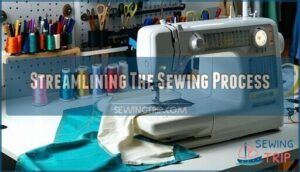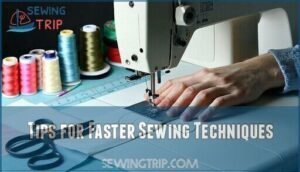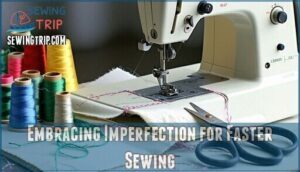This site is supported by our readers. We may earn a commission, at no cost to you, if you purchase through links.
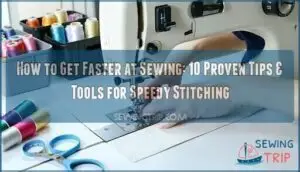
Practice makes perfect, so stitch often, and don’t fear making a mess or breaking a needle or two.
Use handy tools like a ruffler foot or pinking shears to speed things up, and let your sewing machine’s speed knob become your new best friend.
Remember, even the fastest sewists once stitched crooked lines. If you’re craving secrets for cutting your sewing time in half, stick around for more clever tricks.
Table Of Contents
- Key Takeaways
- Top 5 Sewing Accessories to Speed Up Your Sewing
- How to Get Organized for Faster Sewing
- Choosing The Right Fabrics, Patterns, and Styles for Fast Sewing
- Sewing Techniques to Speed Up The Process
- Tips for Time Management in Sewing
- Efficient Fabric Preparation for Faster Sewing
- Streamlining The Sewing Process
- Tips for Faster Sewing Techniques
- Creating an Efficient Sewing Workspace
- Embracing Imperfection for Faster Sewing
- Frequently Asked Questions (FAQs)
- Conclusion
Key Takeaways
- Set up your workspace so every tool and supply is within easy reach, cutting down on time wasted looking for things.
- Use sewing accessories like specialized presser feet, pinking shears, and fabric glue to finish tasks quicker and with less hassle.
- Batch similar tasks together and practice chain stitching to move through projects more efficiently.
- Choose easy-to-handle fabrics and simple patterns to avoid unnecessary frustration and keep your sewing process fast and smooth.
Top 5 Sewing Accessories to Speed Up Your Sewing
If you’re tired of spending ages fiddling with stubborn seams or trimming endless threads, you’re not alone—everyone wants to sew smart, not hard.
Grab these five handy accessories, because the right tool might just save your sanity (and maybe spare you from yelling at your sewing machine).
1. Blind Hem Foot Janome Sewing Machine Accessory
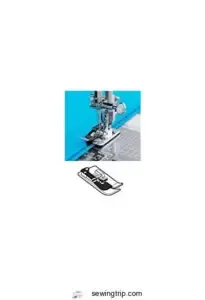
If you dread hand-stitching hems, the Janome Blind Hem Foot will be your new best friend.
This specialty presser foot makes blind hemming as quick as a TV commercial break—just snap it on with its easy foot installation, choose your stitch settings, and away you go!
The sturdy metal guide and handy grooves keep your fabric in line so there’s no slipping or crooked seams, even if you’re racing through cottons or tricky knits.
Compatible with most Janome sewing machines, it’s a sewing machine accessory that turns messy hems into masterpieces, making anyone look like a pro with its ability to create masterpieces.
2. Binder Sewing Machine Presser Foot Fits Low Shank Snap on Brands
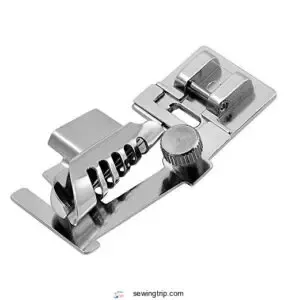
If you thought the blind hem foot was clever, the binder sewing machine presser foot is like your sewing sidekick for pain-free binding.
Snap this foot onto your low shank sewing machine—no wrestling needed. Feed 1/4" bias strips right in, and it folds and stitches them perfectly for crisp, professional-bound edges.
Fits most domestic brands, so you can forget scary Attachment Techniques and just sew. Presser feet guarantee even seams.
For tricky corners or wobbly seams, check your Shank Compatibility Guide and troubleshoot those binding issues with a smile, ensuring professional-bound edges and pain-free binding with the help of your sewing sidekick.
3. Singer Brother Juki Sewing Machine Ruffler Foot
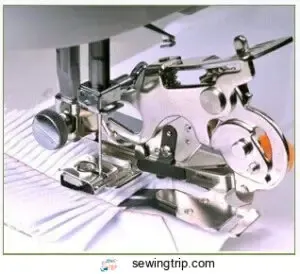
If you liked the last presser foot, you’ll love the Singer Brother Juki sewing machine ruffler foot—it’s the wild stallion of specialty presser feet.
This clever gadget skips the endless hand-gathering and gives you perfect ruffles or pleats at warp speed. Here’s how to make friends with yours:
- Check the Ruffler Foot Types and make sure it fits your sewing machine—compatibility matters.
- Study a Ruffler Attachment Guide or watch a quick YouTube video for setup tips.
- Experiment with different Ruffler Stitch Settings; trial and error is part of the fun.
- Try Decorative Ruffler Projects on pillowcases, skirts, or doll dresses.
- Don’t forget Ruffler Foot Maintenance—clean it often, or those ruffles could get rebellious!
Let your sewing adventure gather speed!
4. Fabric Fusion Permanent Adhesive by Aleenes
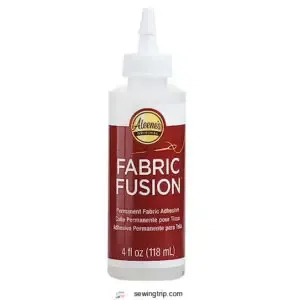
Swap out fiddly needlework for Aleene’s Fabric Fusion—it’s a lifesaver when you need heavy-duty Permanent Hold.
Stick rhinestones, trims, or patches fast, skipping the tangled-thread drama. The water-based formula makes Adhesive Applications mess-free, boosting sewing speed and freeing creative Project Ideas.
It excels at Fabric Bonding and is a top Adhesive Alternative for faster sewing.
| Adhesive Alternatives | Best Uses |
|---|---|
| Aleenes Fabric Fusion | Embellishments |
| Hot glue | Quick patches |
| Fabric glue stick | Light repairs |
| Double-sided tape | Hems |
5. Serrated Pinking Shears Set With Comfortable Handles
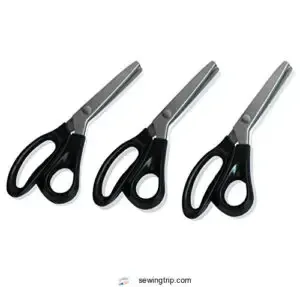
Snipping with pinking shears isn’t just about getting zig-zaggy edges—it’s a trick that cranks up your sewing speed and polishes your fabric edge finish, too.
JulArt’s pinking shears come in a set of three, so you’ve got options for every project, plus those ergonomic handles feel great in your hand.
The sharp, serrated edge quality slices smoothly through layers, making Pinking Shear Uses endless—from fabric to craft paper.
Got butterfingers? No worries, the ambidextrous design’s got you. Just remember: keep your pinking shears clean and sharp. Shear maintenance tips save you snags and headaches later!
How to Get Organized for Faster Sewing
So you’ve got your must-have sewing accessories, but sewing at warp speed is pretty tough if your needles are drowning in fabric scraps and lost bobbins. Let’s turn chaos into calm! A tidy sewing space boosts your sewing productivity like nothing else.
Start with a solid workspace layout—put your machine, ironing board, and cutting area close enough that you could spin in your chair and snag a seam ripper with your eyes closed. Keep tools within arm’s reach, and use clear containers to master supply sorting. Seriously, knowing your favorite scissors aren’t playing hide-and-seek is a gamechanger.
Proper organization starts with effective sewing containers. Keep tools within arm’s reach, and use clear containers to master supply sorting. Seriously, knowing your favorite scissors aren’t playing hide-and-seek is a gamechanger.
Try these:
- Label and roll threads for easy grabbing (and less untangling mayhem).
- Stash a bin for fabric bits—no more runaway scraps underfoot.
- Clean your machine regularly for smooth sewing workflow and peak sewing efficiency.
Embrace sewing organization, and your projects will whiz by!
Choosing The Right Fabrics, Patterns, and Styles for Fast Sewing
If you pick fabrics that behave themselves, patterns without a million tiny pieces, and styles that don’t need fancy finishes, you’ll spend a lot less time wrestling with your sewing machine.
Think of it like making grilled cheese instead of a soufflé—simple choices mean you get to the fun part faster (and with fewer tears).
Fabric Choices for Speed
In the context of speed sewing, smart fabric selection is half the battle.
Go for Easy-Sew Fabrics like cotton broadcloth, linen, or stable knits—these make your needle glide like butter.
Light to medium Fabric Weight trims hassle, while Pattern Simplicity and Minimal Detailing keep you from threading a maze.
Thread Matching ups your sewing efficiency, so you’re always sewing faster.
Using forgiving fabrics like cotton lawn enhances the sewing experience.
Selecting Quick Sewing Patterns
After choosing speedy fabrics, picking the right sewing patterns is like finding a shortcut on your sewing map.
Go for simple pattern features and beginner-friendly patterns—think minimal seamlines and few pattern pieces.
These make pattern alteration easy and keep you sewing faster.
When selecting a pattern, it’s important to compare your measurements with the pattern’s size chart guidelines.
Try these quick sewing pattern tricks:
- Look for “Easy” labels
- Skip tricky closures
- Stick to basic shapes
Efficient Sewing Styles
After picking your quick sewing patterns, try minimalist sewing styles that favor streamlined steps and avoid fussy details.
Think loose fits, elastic waists, and simple structure—perfect for batch sewing quick projects.
Simplified patterns cut stress, and chain stitching is your new best friend.
Explore options for purchasing sewing patterns to further streamline your project selection.
With these time-saving sewing techniques and sewing tips, you’ll improve sewing speed and enjoy efficient sewing every time.
Sewing Techniques to Speed Up The Process
Speed-loving sewists, let’s turn your sewing sessions into well-oiled machine marathons! Master efficient sewing techniques like Chain Stitching to zip through repetitive seams—you’ll trim more than thread, you’ll slice off minutes.
Flat Construction is a true time-saver, letting pieces lie flat like pancakes while you work, so no more wrestling with awkward tubes. Give Batch Sewing a go; line up similar steps and tackle them all in one swoop—think of it as sewing’s version of a relay race.
Don’t forget to bring out your Serger for a one-and-done finish, or switch up your Presser Feet to cruise through tricky hems and bindings. To maintain peak performance, consider regular machine lubrication.
With these sewing tips, hacks, and shortcuts, you’ll look like a speed-demon tailor—without breaking a sweat!
Tips for Time Management in Sewing
If you’ve ever lost your scissors mid-project or gotten sidetracked by a mountain of fabric scraps, you know sewing time management is half the battle.
Let’s keep your projects humming with some sewn-in efficiency:
- Prioritize Tasks: Finish all the prep like winding bobbins or pre-washing fabrics before you hit “start.”
- Batch Sewing: Knock out similar tasks together—like cutting all your pieces or sewing seams in one go. It’s like meal prepping, but for thread!
- Minimize Distractions: A clutter-free workspace means less time hunting for tools and more time stitching.
Set mini deadlines for yourself, pause for efficient breaks, and remember: the best sewing hacks sometimes come from simply staying organized.
Effective strategies include managing sewing projects.
With these sewing shortcuts, you’ll finish your sewing projects faster—and happier!
Efficient Fabric Preparation for Faster Sewing
Nobody wants a shrunken shirt after the first wash—that’s where prewash benefits come in handy.
Prewashing your fabric nixes shrinkage and washes away any sizing or weird factory smells. Take a quick look for color flaws or snags before you kick off your project, so you don’t discover a problem halfway through.
When it’s time to mark, use tailor’s chalk, fabric markers, or make small notches—trust me, you’ll thank yourself during assembly.
Layer cutting is a game changer: stack up those fabrics and slice multiple pieces at once with your trusty rotary cutter.
Skip the pins and grab some pattern weights for faster, frustration-free fabric cutting. Always double-check grainlines and use patterns that include seam allowances.
Proper prep means less time fixing mistakes and more time actually sewing!
Streamlining The Sewing Process
Once your fabric’s ready to roll, the magic really happens with how you streamline your sewing process.
Treat your workspace like a crafty command center—think ergonomic setup, keeping everything you need close so you’re not playing hide-and-seek with scissors.
Batch sewing lets you roll through seams like you’re working the world’s quietest assembly line—stitch all the right sides, press, then tackle the next task, rather than ping-ponging between steps.
Prioritize your tasks, avoid shiny distractions (as tempting as that phone is), and plan your sewing project just like a chef preps ingredients—everything prepped, in order, to achieve a consistent workflow that speeds things up and zaps frustration.
Addressing issues such as bottleneck identification can substantially improve workflow, and little sewing efficiency strategies can make a huge difference—soon, you’ll be optimizing your sewing workflow like a pro, using techniques to improve workflow and increase overall sewing efficiency.
Tips for Faster Sewing Techniques
If you’ve ever felt like you’re chasing your own tail between cutting, stitching, and daydreaming about lunch, it’s time to let a few faster sewing techniques work their magic.
Tools like specialized presser feet can make Efficient Stitching and Seam Mastery feel like second nature. Toss in a ruffler foot, fabric glue, and pinking shears, and suddenly Batch Sewing and Thread Control don’t sound like chores.
Want to shave minutes off each project? Try these timesaving tips:
- Swap pinning for fabric glue to hold layers in place—no more poked fingers!
- Use presser feet attachments for swift binding and blind hemming.
- Finish raw edges with pinking shears for a clean, quick cut.
For inside seams, consider using gray thread options to save time on color matching. A little sewing optimization goes a long way toward a smoother workflow!
Creating an Efficient Sewing Workspace
How do you turn chaos into creativity in your sewing space? Start by setting up an ergonomic workspace—keep your machine, cutting area, and pressing station close so you aren’t running a mini-marathon every time you switch tasks.
Bright lighting isn’t just for glam selfies; it cuts eye strain and helps you spot errors before they become “design choices.” Storage ideas like labeled bins or drawers mean you’ll spend less time searching for bobbins and more time stitching.
Place your favorite tools within arm’s reach, and don’t forget accessibility tips: a comfy swivel chair works wonders for your back and workflow. Try this quick cheat sheet for better workspace organization:
| Ergonomic Setup | Lighting Solutions | Storage Ideas |
|---|---|---|
| Swivel chair | LED task lamps | Labeled bins |
| Machine nearby | Natural light boost | Drawer dividers |
| Pressing station | Adjustable lighting | Pegboard for tools |
| Cutting area | Overhead lights | Clear containers |
Tidy space, happy sewing!
Embracing Imperfection for Faster Sewing
A wobbly seam or slightly off-center button isn’t a disaster—it’s an Acceptable Flaw and a badge of handmade charm.
Give yourself permission to skip that endless quest for sewing perfection. Chase sewing speed with Quick Fixes like fabric glue for embellishments and Creative Coverups when a line goes astray.
Forgo pressing after every seam, let those Imperfect Finishes add character, and enjoy the process more. Relaxed Standards save real sewing time, so move from step to step with confidence.
Embracing these sewing tips and tricks boosts sewing efficiency, and also leaves you with stories in every stitch—perfectionists need not apply!
Frequently Asked Questions (FAQs)
How do I get better at sewing?
You’ll be sewing like lightning before you know it!
Set up your workspace like a pro, keep your tools close, practice straight stitching daily.
Don’t fear mistakes—they’re just fabric’s way of teaching you a lesson.
Is it faster to sew without pinning or basting?
Skipping pins and basting saves time, but it’s a bit like riding a bike with no hands—tricky.
If your fabric behaves, go for it.
If not, a few pins keep wonky seams from popping up, which can be tricky.
How can I improve my sewing skills?
Picture Jamie, who once stitched a sleeve inside out—haven’t we all?
Practice different seams, try new fabrics, ask for feedback, and don’t shy away from mistakes.
A good seam ripper and humor are your best friends!
Is it faster to sew French seams with a serger?
French seams with a serger are like trying to butter toast with a fork—possible, but awkward.
Sergers don’t work for traditional French seams; stick to your regular machine for neat, enclosed edges.
Keep calm, and stitch on!
What fabrics should I sew in the first few months?
You’ll want to try cotton, linen, and broadcloth since they’re easy to handle and don’t slip around.
Steer clear of silky or stretchy fabrics at first—save those for when you’ve tamed your thread monster!
Is it faster to sew French seams or straight stitches?
Nearly 30% of sewists say straight stitches save them the most time.
You’ll zip through projects using straight stitches—French seams take longer since you sew each seam twice.
Quick tip—skip the fancy stuff when you’re racing the clock!
How to get better at sewing fast?
To get better at sewing fast, keep your space tidy, group similar tasks together, and use chain stitching.
Practice straight lines—crooked seams slow you down!
Prep fabric ahead, and hey, don’t forget to oil your machine regularly, which helps in maintaining a smooth workflow with straight lines.
How do people sew so fast?
Like lightning through a summer sky, you’ll sew fast by keeping tools close, cutting fabric in batches, using a rolling chair, and chaining seams together.
Practice makes you swifter—before you know it, you’ll stitch circles around the clock!
Is sewing a skill or talent?
Sewing is definitely a skill you can learn, not a hidden talent people are just born with.
Sure, some folks pick it up faster, but practice, patience, and maybe a few pricked fingers get everyone there!
How long does it take to get really good at sewing?
Mastering sewing is a bit like learning to ride a bike—expect wobbly stitches for the first year.
Give it two to five years of regular practice, and soon, you’ll be zipping along with confidence.
Conclusion
Like a well-oiled machine, you’ll zip through projects once you put these clever tricks for how to get faster at sewing into action.
Keep your tools close, use those nifty feet and shears, and let small mishaps roll off your back—broken needles are just battle scars.
Practice patience (and speed!) with every stitch, and pretty soon, you’ll wonder why you ever waited around for slow seams.
Get ready, your sewing projects won’t know what hit them, and with consistent practice, you will master the art of sewing efficiently.



